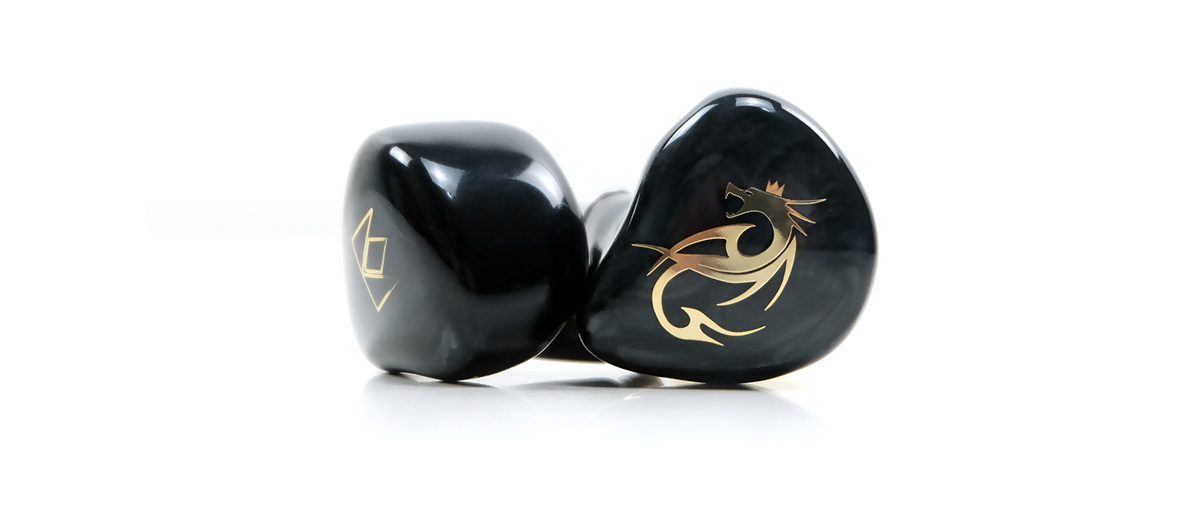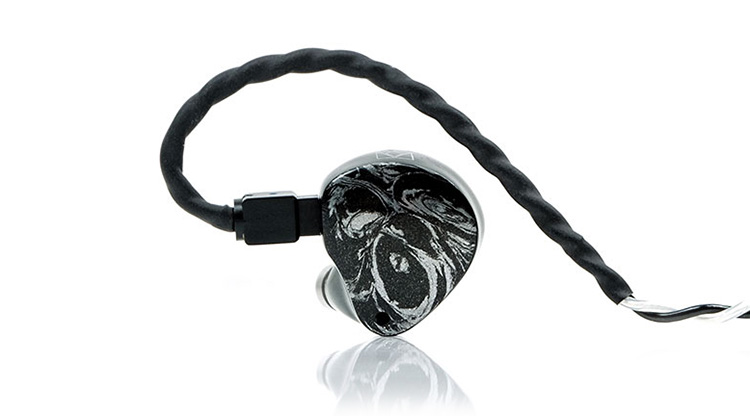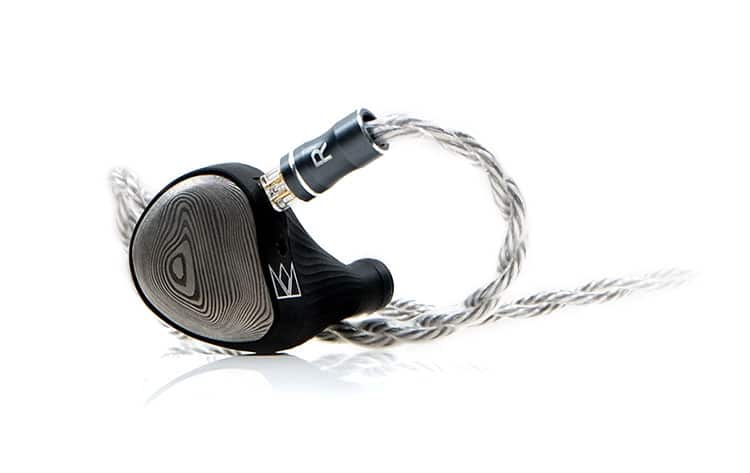Select Comparisons
All comparisons were completed using a mix of the HiBy RS8 and the Cayin N8ii as the main source. Tips used were the stock grey foam tips for all 3 competing monitors.
Noble Audio Khan
$2399
The Khan was the original or the predecessor to the Kublai Khan launched back in 2019. It was also our Top Gear Award winner for that year. You can read up on the Khan full review here.
Technical
The Kahn serves as the foundation for the Kublai Khan, so there is a lot of technical overlap. Both are tribrids with a total of 6 active drivers including a 10mm dynamic driver, 4 Knowles BA for the mids to highs, and a 10mm piezoelectric ceramic driver for the highs.
Where the Kublai differs markedly is the introduction of that woofer-targeted bone conduction driver that is tuned in tandem with the response of the dynamic driver for some additional physicality from the sub-bass of the dynamic driver.
Noble is a bit conservative when it comes to any specific technical specifications but in our real-world tests using the 3.5mm SE output in low gain turbo mode from the HiBy RS8, I could not find any difference between the two volume-wise.
I would presume the specs have not changed that much, at least for SPL which in 2019 I felt was about 105-110dB @1kHz for the Khan and both are likely to be under 30Ω so regular DAPs and good quality dongles will work just fine.
The final tech change-up is the cable with the Kublai Khan using a 1.2m 8-core OCC wire whereas the Khan came with a stock 4-wire SPC of the same length. I find SPC can be feistier than copper and 4-wire is more resistive than 8-wire which may be one of the factors in their tuning difference.
Design
The Kublai Khan has the larger form factor of the two monitors but also offers a little more contouring for fitting purposes over the original. Both are resin models as opposed to the older unibody universal designs from a few years back though again a difference in aesthetics.
The original Khan uses an attractive M3 composite twist on the traditional Mokume Gane metallurgy process for a striking high contrast faceplate. The Kublai Khan dials back on the punchy color combo and opts for a more subdued marble blue/grey blended pattern behind the high-res gold dragon emblem, (or the Noble crown on the other side).
Both are finished with black vented shells, long nozzles, and stainless-steel caps with wire mesh to keep out the dirt. The one other striking visual design difference is the dragon-branded bone conduction plate at the base of the Kublai Khan shell which needs to be there to get the best possible vibration transmission to your skull.
Both are comfortable fits but both also rely a lot on a good tip to get the best seal and sitting. I do find that both the Khan and Kublai Khan work best with the supplied foam tips with the Kublai Khan isolating a little bit more.
Perhaps due to the increased size it will cover more of your canal opening to block out some background noise but in turn, it will feel a touch heavier in your ear compared to the original.
Performance
The Kublai Khan is the smoother more voluptuous version of the original Khan. Noble has done some tuning work on the dual BA for the mid-highs and piezoelectric drivers because that enhanced smoothness is one of the initial differences you will notice.
I would say the original Khan’s 5-8k treble peak has been either flattened or softened just a little but either way the effect is to give the Kublai Khan less of a treble fizz from the older tuning and more of natural sparkle to vocal and upper mids percussion timbre.
The other timbral change is the amount of comparative warmth in the tuning, (when used with foams). It is not a rounded tone but it is a more evenly balanced natural sound from the Kublai Khan over the drier higher contrast presentation of the original Khan.
That means vocals sound more natural to my ear, and a little bit more full-bodied also in their delivery. However, for imaging purposes, I do not find them to be distinctly different in their placement meaning a little more on the neutral side of the Harman Target curve but not by much.
Much of that enhanced body comes from a better-performing bass tuning. In part, the bone conduction will do its thing but on a high level, it does seem the basic amplitude of the Kublai Khan’s bass response has gone up by a few dB across the curve from 20Hz up to 100Hz and less of an upper bass scoop.
The net effect is a more voluminous low-end, stronger sub-bass presence, and a bit more mid-to-upper bass elevation to create that fuller more powerful bass presentation. That gives the lower-mids to mids instruments a better fundamental and improves the harmonic balance throughout the mids compared to the original.
Noble Audio Sultan
$2900
The Sultan was launched in mid-2020 and until the Viking series was Noble TOTL monitor. It is still part of the official flagship series and price-wise positioned slightly above the Kublai Khan. You can read our full review of the Sultan here.
Technical
The driver configuration of the Sultan also has a degree of overlap with the Kublai Khan. You get a total of 7 drivers as opposed to Kublai Khan’s 6+1 with a similar single 10mm dynamic and four Knowles BA for the mids and highs.
However, instead of a piezoelectric driver for the highs and ultra-highs, you get a Sonion dual electrostatic driver and transformer combo inside the Sultan. Are they the exact same dynamic and BA drivers between the two models only Noble knows but the tuning is indeed quite different.
One of those differing factors is the Kublai Khan’s bone conduction subwoofer driver which runs alongside the dynamic driver, something which the Sultan does not use.
The ratings of both are officially unlisted but once again using the HiBy RS8’s SE 3.5mm out and in turbo mode low gain, the Sultan was a good deal more sensitive than the Kublai Khan, by at least 7-10 steps depending on your preferred listening level.
So, if both are under 30-35Ω I would say the Sultan SPL is above 110dB @1kHz based on this simple side-by-side test. That heightened sensitivity might mean the Sultan is more prone to picking up background hiss in some DAPs such as the N6ii with the E02 motherboard whereas the Kublai Khan does not.
Design
The Sultan design is more of an exotic evolution of the unibody format from a few years back and overall, I would give it a slightly higher rating than the Kublai Khan for both the aesthetics and quality of materials used.
Do not get me wrong, the Kublai Khan contoured resin design is mature, widely accepted as a comfort-friendly format, and striking in its own way with that gold dragon motif on the shell.
However, Sultan’s stunning hand-finished aura or Galaxy swirl-type amber facade on the plates combined with the external ribbed 2-piece uniform aesthetic taken from the Kaiser Encore and Katana is very unique and eye-catching.
The Sultan shells are cut from a single aluminum block and given a more distinctive shape than the aforementioned monitors. It is then finished in anodized two-tone silver and charcoal colors so it looks a lot busier than the Kublai Khan which might be a preference for people who like a lower profile monitor in their ear.
The Kublai Khan is the bigger of the two monitors with a longer nozzle also. Comfort wise the Kublai Khan’s resin material will sit comfier and lighter in the ear but since they are long-nozzle creations the isolation and seal will come down to the tips more than anything.
There is less contact with the ear from the Sultan but that’s fine as the tips do the heavy lifting and you need more of the Kublai Khan shell touching for the bone conduction driver to work. Since both come with the same tip selection both seem to work best with the wide-bore grey foam tips.
Also, both monitors come with the same 8-core OCC 1.2m cable so no difference there either.
Performance
The Kublai Khan is going to come across as the cleaner, more neutral-sounding monitor but this is contextual as the Sultan is quite a euphonic-sounding hybrid in its own right.
The key differences here are on both ends of the FR and what seems to be a comparatively flatter midrange imaging experience from the Sultan. Both have elevated low-ends but there is less of a scoop from the Sultan tuning beyond the mid-bass and more of a gentle slide into the mids.
That generates a bit more mid-to-upper bass bloom in the presentation. This is something that the Kublai Khan cuts down on a bit more, which in turn enhances the perception of a clear bass to mids separation and a bit more space.
That relative space and air on the Sultan are also a little bit more suppressed on the upper-mids side with a 3-4k dip that takes a bit of fizz and sparkle out of higher pitching vocals and percussion timbre.
Combined with a bit more warmth from the bass lift means a more rounded euphonic tone from the Sultan vocal and percussion timbre. The Kublai Khan projects a bit stronger through the mids, with less of an upper mids cut also so it sounds airier, cleaner, and with more space afford for instruments and vocals to come through.
I always thought the Sultan had an excellent timbral balance but comparing it to the Kublai Khan I can see where the tuning has evolved over the last few years. The new Kublai Khan tuning is definitely cleaner but also clearer and with a smarter FR balance that teases out a better perception of detail and space.
Noble Audio Viking Ragnar
$4000
One of a raft of new releases, the Viking Ragnar is the head honcho of Noble’s flagship series of universal IEMs. It is also our Top Gear Ward winner for 2022. You can read our full review of the Viking Ragnar here.
Technical
The Ragnar is a bit of a jump up from the Kublai Khan but at this price point, I would expect that. Both are hybrid configurations with the Viking using 10 drivers in total as opposed to 6+1 inside the Kublai Khan.
The price grouping for the Viking is a new dual 10mm dynamic driver setup for the lows, dual BA for the mids, dual BA for the mid-highs, and a quad electrostatic array for the highs. The Kublai Khan is a single 10mm dynamic driver for the lows, 4 BA for the mids and highs, and a single 10mm ceramic piezoelectric drive for the ultra-highs.
We also know that the Viking uses a 4-way crossover and though not listed for the Kublai Khan I would presume 3-way for its smaller driver count grouping.
What the Viking lacks is an additional bone conduction driver layered alongside the dynamic driver though you could argue that a dual dynamic driver low-end tuning might not need that.
Surprisingly, Noble has been quite open about the technical ratings of the Viking Ragnar which has a 17Ω impedance and 112dB sensitivity @1kHz. All we know is that Kublai Khan is under 30Ω but in our real-world tests with the Cayin N8ii, it did seem marginally quieter than the Ragnar using the 4.4mm balanced low gain P+ mode.
Design
It’s a 4k IEM, it’s a flagship, and it has the ‘wow factor’ in terms of design. Noble pulled out the stops with the Ragnar in terms of both materials and finishing to create a very intricate aesthetic.
Like the Sultan, the Ragnar main shell is a ribbed 2-piece uniform aesthetic. The shells are cut from a single aluminum block and given a distinctive shape with that long nozzle.
The main shell is then finished in an anodized matte black coating which gives it more of a grippy finish compared to the glossier Sultan shell. The plate is Damascus stainless-steel which has this inherent wavy or watery pattern on its surface brought about by a layered mix of various VG steel types combined with alternative metal elements.
By contrast, Kublai Khan looks sleek, well made, and bang up to standard for what I expect a quality IEM to look like but it perhaps does not step out of the unusual. Excellent finishing, yes, comfortable fit more certainly, but more subdued looking save for the gold dragon emblem and the unique visual of the base of the bone conduction driver.
The Kublai Khan has a bigger former factor with a longer nozzle. Both fit well though but you do feel the Kublai Khan sticks out a bit more. Tips are important for both seal and tuning coloration. I prefer the Final E tips with the Ragnar but the stock foam tips suit the Kublai Khan better.
The Ragnar stock Magnus 4-wire graphene, monocrystalline silver, and a copper-silver cable is also an upgrade over the 1.2m OCC 8-wire that comes with the Kublai Khan. I like both cables though and they handle equally as well as each other but the flashier design belongs to the Magnus.
Performance
The more immediate difference between these two is more on the technical side in terms of soundstage capability with some subtle timbral differences coming through also.
Starting with the timbral differences, and if anything, the Ragnar treble has a bit more bite in it that gives the midrange timbre some additional contrast and a slightly shorter decay.
However, with foam tips, I tend to find it is nicely balanced between smooth and precise whereas, with the foam tips on the Kublai Khan, it is a bit further to the smoother side.
You can hear that difference also on the low end where the Ragnar bass response comes across as a little tighter, punchier, and more defined in its delivery. The Kublai Khan is close but just a shade softer in the mid-bass and with a slightly slower attack and decay.
The bigger or more obvious difference is the staging dimension and level of airy resolution from the Viking Ragnar. In short, it serves up a much wider and more holographic soundstage. Every instrumental and vocal image feels incredibly well spaced out with an almost HD800-like headroom and impressive left-right separation.
In comparison, the Kublai Khan stage is tall and deep, but overall, feels like someone switched on a crossfeed filter and pulled Ragnar’s expanse in a little bit sounding more centered and less dynamic in its delivery.
You could argue that the softer mids and treble tone will give you a more forgiving quality to the Kublai Khan delivery. That’s a valid good point for some setups but paired with something like the Cayin N8ii or the HiBy RS8 with plenty of voltage the Ragnar never comes across as sharp to my ear. Simple more precise and vivid sounding.
Our Verdict
The Noble Audio Kublai Khan is more than just a ‘lick of paint’ on the original Khan from 2019.
It still retains the hallmarks of the first gen with its peppy highs and above-neutral sub-bass response. However, this time around it sounds more mature, refined, and dynamic in its delivery and generally a much more agreeable high-end tuning.
For those who cannot afford to go all out for the Viking Ragnar, the Kublai Khan will give you a rewarding taste of that flagship sound and for some, it might actually offer even more flexibility for source and tip matching.
Overall, this is a clever tuning upgrade that should appeal to those looking for a nice blend of clarity and ‘musicality’ rolled into one high-end monitor.
Noble Audio Kublai Khan Specifications
- Composite body with unique acetate faceplate
- Stainless-steel nozzle with an integrated wax guard
- 1 10mm dynamic driver
- 1 bone conductor subwoofer
- 1 10mm peizo super tweeter
- 4 balanced armature drivers
- Impedance less than 35 ohms
- Sensitive enough for use with most smartphones as well as portable amps and DAPs
- Detachable 8-core cable with industry standard 2-pin configuration (0.78 mm diameter)





